Can You Freeze Buttercream Frosting
You can safely freeze buttercream frosting for up to three months, letting you stockpile your leftover frosting and reduce food waste while keeping your baking supplies organized. When storing, use an airtight container or freezer bag, pressing plastic wrap directly onto the surface to prevent freezer burn. Label and date the container, and thaw frozen buttercream overnight in the refrigerator or at room temperature for a few hours before re-whipping. With proper storage and thawing, your frozen buttercream will be ready to use again, and you'll discover even more ways to get creative with your baking by exploring the world of frozen frosting possibilities.
This post may contain affiliate links. If you make a purchase through these links, I may earn a commission at no additional cost to you. Additionally, portions of this post may be generated using artificial intelligence (AI) technology. While we strive for accuracy, please be aware that AI-generated content may not always be perfect and should be fact-checked when necessary.
The Spatula Scoops
- Yes, buttercream frosting can be frozen for up to 3 months in an airtight container or freezer bag.
- Press plastic wrap directly onto the frosting's surface to prevent freezer burn and store in an airtight container.
- Label and date the container with the type of frosting and the date it was frozen for easy identification.
- Thaw frozen buttercream frosting overnight in the refrigerator or at room temperature for a few hours before re-whipping.
- Re-whip thawed buttercream frosting to restore its original texture and consistency after thawing.
Storing Buttercream in the Fridge

Convenience is key when working with buttercream frosting, and refrigeration is a vital step in keeping it fresh for your next baking project. You'll want to store your buttercream in the fridge to maintain its consistency and prevent spoilage. Similar to cakes with cream cheese frosting, which should be consumed within 2-4 days due to perishable ingredients cake storage time guidelines, proper storage is imperative to extend its shelf life. When refrigerating, make sure to transfer the frosting to an airtight container to prevent air from seeping in and causing it to dry out. You can store it in the fridge for up to a week, and it's best to bring it to room temperature before using it again. This allows the frosting to soften and become pliable, making it easier to work with. If you don't plan to use your buttercream within a week, you can consider freezing it – but we'll get to that later. For now, refrigeration is a great way to keep your buttercream fresh and ready for your next baking project. By following these simple steps, you'll be able to enjoy your buttercream frosting for a longer period.
Freezing Buttercream for Later
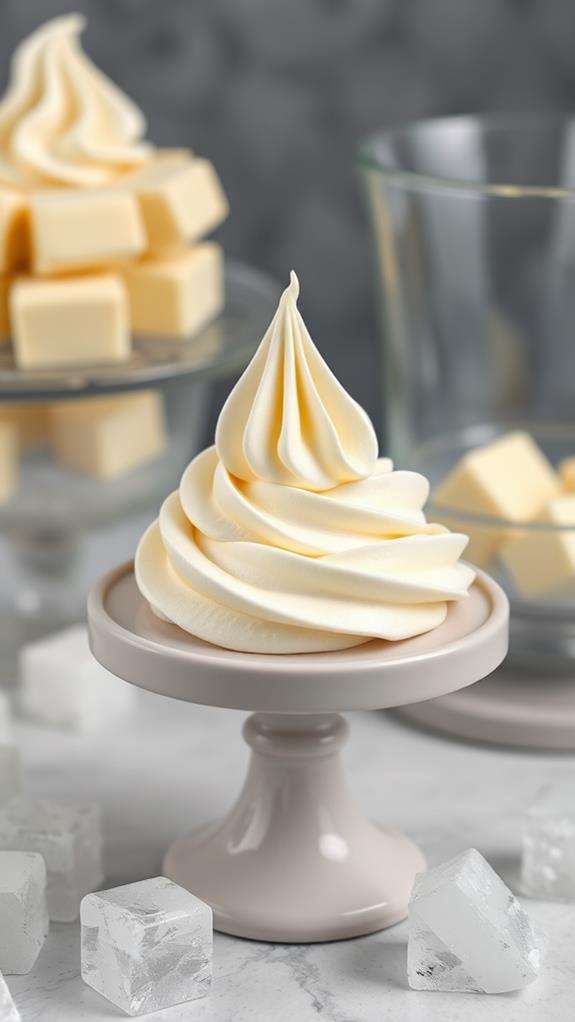
You've got a stash of buttercream frosting that you don't plan to use immediately, and you're wondering how to keep it fresh for later. Freezing is a great option, and the good news is that buttercream frosting can be frozen for up to 3 months in an airtight container or freezer bag. This allows for convenient storage and reuse, making it perfect for busy bakers and decorators. When freezing buttercream frosting, crucially, you must press plastic wrap directly onto the surface of the frosting to prevent freezer burn and maintain its texture. You can also consider using flexible, food-safe silicone freezer molds like Souper Cubes to portion and freeze your frosting, making it easy to thaw and use only what you need. Simply place the wrapped frosting in an airtight container or freezer bag, and you're good to go. When you're ready to use it, thaw the frozen buttercream frosting overnight in the refrigerator or at room temperature for a few hours before re-whipping and using. With proper storage, your frozen buttercream frosting will be ready to go whenever you need it, saving you time and effort in the long run.
Softening and Re-Whipping Frosting
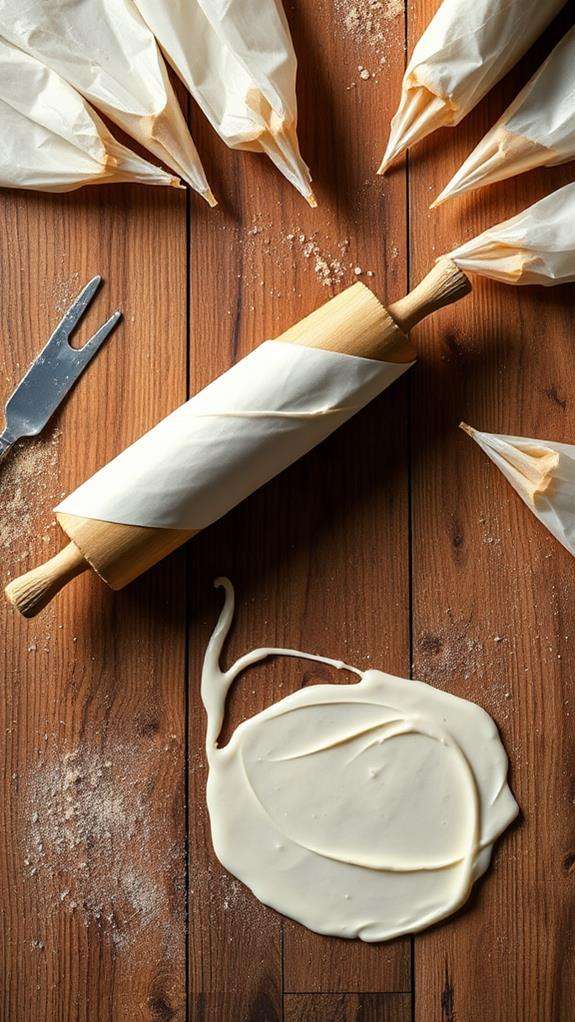
When you're ready to use your frozen buttercream frosting, vitally, you must soften and re-whip it to restore its smooth, creamy texture.
Before re-whipping, you'll need to let your frozen buttercream thaw to room temperature. If it's been in the fridge, take it out and let it thaw at room temperature. If it's been in the freezer, transfer it to the fridge the day before using to defrost gradually, then let it come to room temperature.
| Step | Action |
|---|---|
| Thawing | Take buttercream out of the fridge or freezer and let it thaw at room temperature |
| Re-whipping | Whip the thawed buttercream to get rid of air bubbles and restore smooth texture |
| Final Check | Verify buttercream is at room temperature before re-whipping for best results |
Re-whipping helps get rid of air bubbles that may have appeared during the freezing and thawing process. Defrosting a large amount of buttercream may take two days, so plan accordingly. Once thawed, let buttercream come to room temperature before re-whipping to verify it's smooth and creamy.
Thawing Frozen Buttercream Frosting
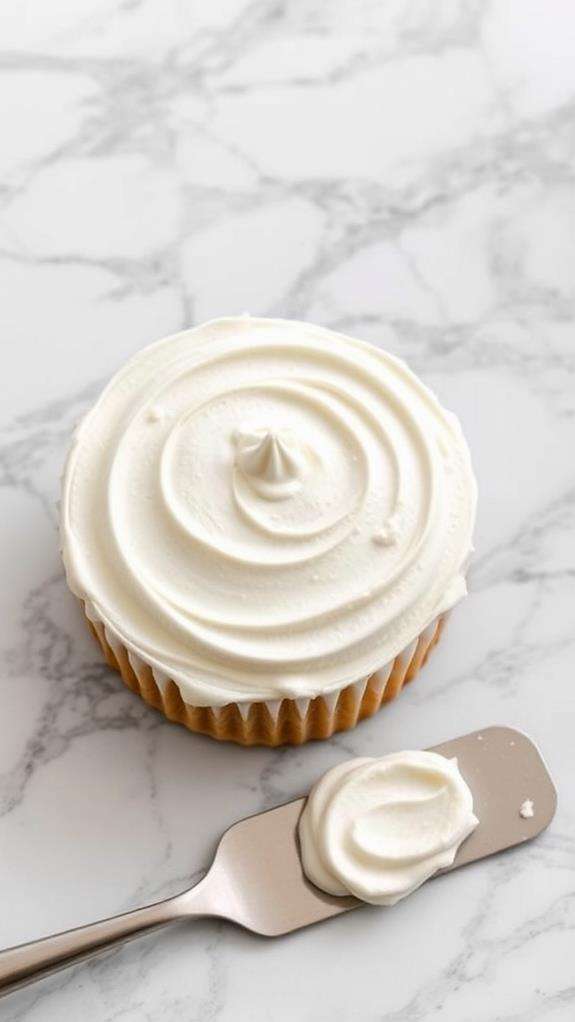
About two hours, give or take, is all it takes for frozen buttercream frosting to thaw at room temperature. To defrost, remove the frozen buttercream from the freezer and unwrap it. When you're ready to bake, consider using a high-quality jelly roll pan like the USA Pan Nonstick Jelly Roll Pan, which features a commercial grade heavy gauge aluminized steel construction for even baking and easy release of baked goods. Place it in a bowl, cover with plastic wrap, and let it defrost. If you've frozen it in a container, simply set the entire container on the counter to defrost. Once defrosted, stir or re-whip the buttercream before using. You can also thaw frozen buttercream in the refrigerator overnight, then let it come to room temperature before re-whipping. Defrosted buttercream is ready to use in various recipes, but it's crucial to re-whip it to get rid of air bubbles that may have appeared during the freezing process. Keep in mind that defrosting a large amount of buttercream may take two days, so plan ahead to guarantee it's ready when needed. By following these steps, you'll be able to successfully thaw and use your frozen buttercream frosting.
Using Leftover Buttercream Frosting
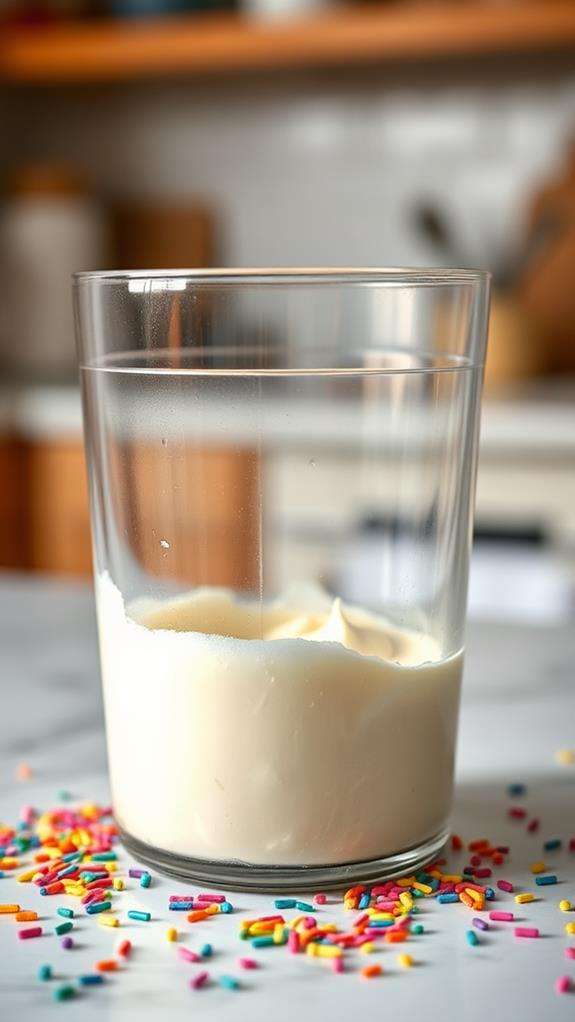
With leftover buttercream frosting, the possibilities are endless, and it's a shame to let it go to waste. You can get creative with it and make something new or use it to enhance an existing dessert. Here are some ideas to get you started:
- Make cake pops: Use leftover frosting to bind crushed cake and form into bite-sized balls. Dip the balls in melted chocolate and decorate with sprinkles or chopped nuts.
- Frost cookies or brownies: Give your baked goods a fresh coat of frosting to revamp their look and taste.
- Create a frosting sandwich: Place a dollop of leftover frosting between two cookies or wafers for a sweet surprise.
- Store it for later: Scoop the leftover frosting into an airtight freezer bag and store it in the freezer for up to three months. When you're ready, simply thaw and use as needed.
Remember to label the freezer bag with the date and contents, so you can easily identify it later. With a little creativity, you can turn leftover buttercream frosting into a new dessert or a convenient topping for your next baking project.
Tips for Freezing American Buttercream
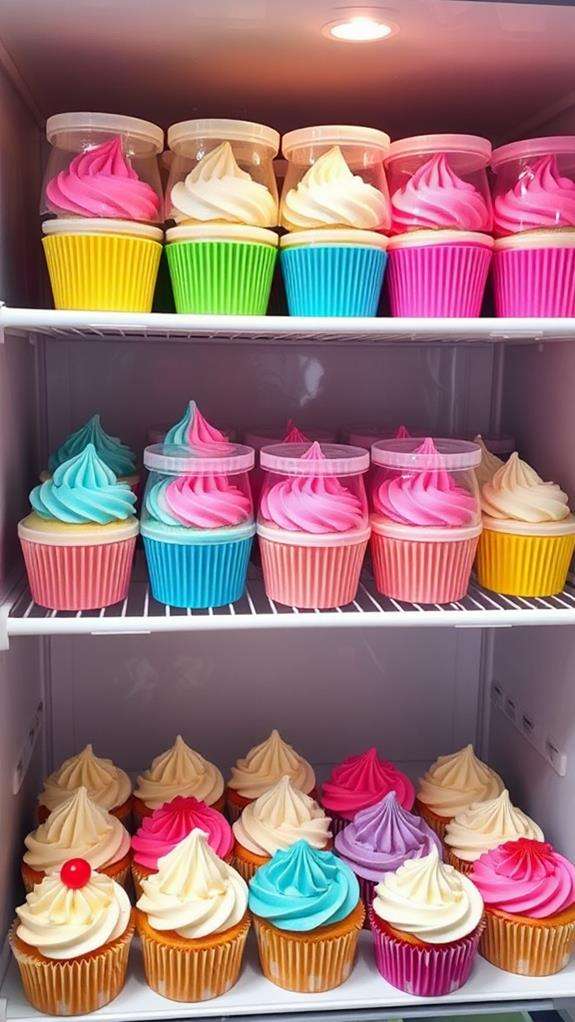
When freezing American Buttercream, you'll want to follow specific methods to guarantee your frosting remains fresh and usable. You can scoop 1-1.5 cups of buttercream onto plastic wrap, fold, and twist to seal, then place it in a freezer ziplock bag and label. By doing so, you'll be able to store your frosting for up to three months and thaw it when you're ready to use it.
Freezing Methods Explained
Freezing American Buttercream frosting requires some strategy to keep it fresh and usable for months to come. You'll want to avoid freezer burn and keep the frosting smooth and creamy.
To freeze your buttercream, you have a few options:
- Portion Control Method: Scoop 1-1.5 cups of frosting onto a piece of plastic wrap, fold, and twist the ends to seal, then store in a freezer ziplock bag for up to 3 months.
- Cheater & No-Time Method: Fill a plastic container with buttercream, leaving little air space, and store it in the freezer for short-term use.
- When freezing, this is crucial: press plastic wrap directly onto the surface of the frosting to prevent freezer burn.
- Frozen buttercream can be thawed in the refrigerator overnight or at room temperature, then re-whipped before using.
Frozen Frosting Storage Tips
Store your frozen American Buttercream frosting like a pro by following these essential storage tips. When freezing, scoop your frosting into a freezer bag, making sure to remove excess air before sealing the bag. You can also use a freezer-safe container, as long as it's airtight. To prevent freezer burn, press plastic wrap against the surface of the frosting before sealing the container or bag. Don't forget to label your storage container or bag with the date and contents, so you can easily keep track of how long it's been stored.
Frozen buttercream can be stored for up to 3 months in an airtight container or freezer bag. When you're ready to use it, simply thaw the frozen buttercream frosting overnight in the refrigerator, then let it soften on the counter for an hour or two before re-whipping. By following these storage tips, you'll be able to keep your frozen buttercream frosting fresh and ready to use whenever you need it.
Thawing and Re-whipping
Patience is key when it comes to thawing and re-whipping your frozen American Buttercream frosting. You'll want to thaw it in the refrigerator overnight before re-whipping. This slow thawing process helps prevent the formation of air bubbles that can affect the frosting's texture.
Before re-whipping, bring the thawed buttercream to room temperature. This step is vital in removing any air bubbles that may have formed during freezing. Now, it's time to re-whip the thawed buttercream frosting to restore its original texture and consistency.
- Thaw frozen buttercream frosting in the refrigerator overnight before re-whipping.
- Bring thawed buttercream to room temperature before re-whipping to remove air bubbles.
- Re-whip thawed buttercream frosting to restore its original texture and consistency.
- Defrosting a large amount of buttercream frosting may take two days, so plan accordingly when thawing and re-whipping.
Freezing Methods and Techniques
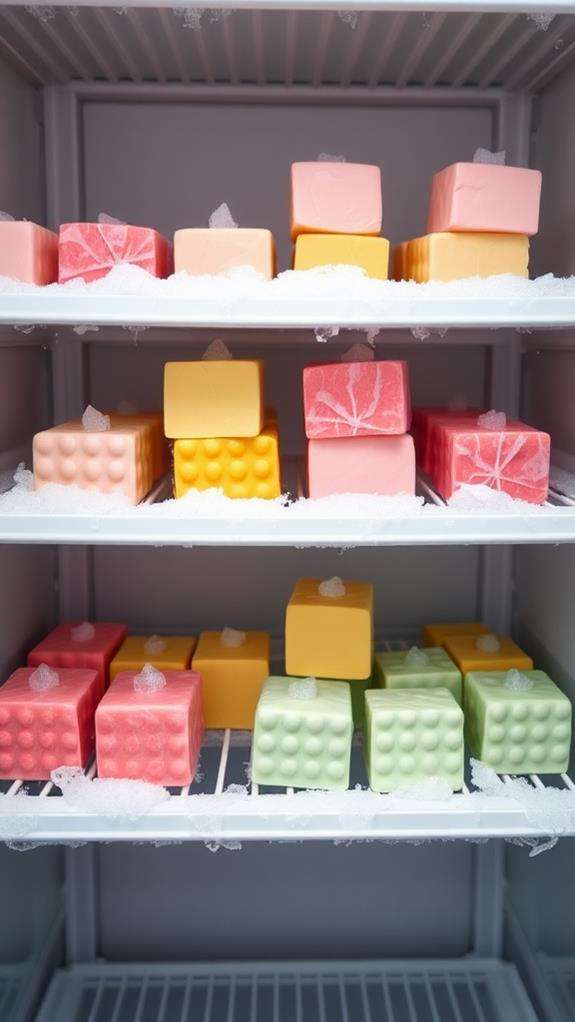
Scoop, wrap, and roll your way to preserving buttercream frosting for future use. When freezing buttercream frosting, you'll want to scoop 1-1.5 cups of it onto a piece of plastic wrap, fold the wrap over the frosting, roll it up, and pinch the ends to seal. This method allows you to freeze individual portions, making it easy to thaw only what you need. Alternatively, you can use the Cheater & No-Time Method, which involves filling a plastic container with buttercream frosting, leaving little air space, and storing it in the freezer for short-term use. Regardless of the method you choose, crucially, you must press plastic wrap directly onto the surface of the frosting to prevent freezer burn. Frozen buttercream frosting can be stored for up to 3 months in an airtight container or freezer bag. By following these simple steps, you'll be able to freeze your buttercream frosting with confidence, ensuring it remains fresh and ready to use when you need it.
Thawing and Using Frozen Frosting

When you're ready to use your frozen buttercream, you'll need to thaw it properly to guarantee it's smooth and creamy. You'll want to remove the wrapping and let it defrost at room temperature, or set the entire container on the counter if you've frozen it in a container. Once thawed, you'll need to re-whip the buttercream to get rid of any air bubbles that may have formed during freezing.
Defrosting Frozen Frosting
You've successfully frozen your buttercream frosting, and now it's time to defrost it and get back to decorating. To do so, remove the frozen buttercream from the freezer and unwrap it, then place it in a bowl, cover with plastic wrap, and let it defrost at room temperature. If you froze it in a container, simply set the entire container on the counter to defrost.
Once defrosted, you'll need to stir or re-whip the buttercream before using it to get rid of any air bubbles that may have appeared during freezing. Here's what you need to do:
- Let the buttercream defrost at room temperature, either in a bowl or in its original container.
- Once defrosted, stir or re-whip the buttercream to remove air bubbles.
- Check the texture and consistency of the buttercream; if it's been stored for too long, you may need to re-whip it for a longer period.
- Your defrosted buttercream is now ready to use in various recipes, such as frosting cakes, cupcakes, or cookies.
Remember to re-whip the buttercream until it regains its original texture and consistency before using it in your recipe.
Thawing Methods Explained
At room temperature, frozen buttercream frosting begins to thaw, allowing you to restore its original texture and consistency. To thaw, remove the frozen buttercream from the freezer, unwrap it, and place it in a bowl. Cover it with plastic wrap and let it defrost at room temperature. If you froze the buttercream in a container, simply set the entire container on the counter to defrost. Once defrosted, stir or re-whip the buttercream before using. Keep in mind that defrosting a large amount of buttercream may take two days, so plan accordingly to guarantee it's ready when needed. Once thawed, let the buttercream come to room temperature before re-whipping to get rid of air bubbles that may have appeared in the frosting during freezing. Re-whipping the thawed buttercream helps to restore its original texture and consistency, making it ready to use in various recipes. By following these thawing methods, you can successfully defrost and use your frozen buttercream frosting.
Using Frozen Buttercream
Now that you've successfully thawed your frozen buttercream frosting, it's time to use it in your favorite recipes. Before you start, make sure to re-whip the defrosted buttercream to get rid of any air bubbles that may have appeared during the freezing process. This step is pivotal to achieve a smooth and consistent texture.
- Re-whip the buttercream: This step helps remove air bubbles and guarantees a smooth consistency.
- Check the texture: If the buttercream has separated or has an inconsistent texture, it's best to re-whip it again.
- Use it as usual: Your defrosted buttercream is now ready to use in cakes, cupcakes, or cookies.
- Store leftovers properly: If you have leftover buttercream, store it in an airtight container in the refrigerator or freezer to maintain its freshness.
Making the Most of Leftover Frosting
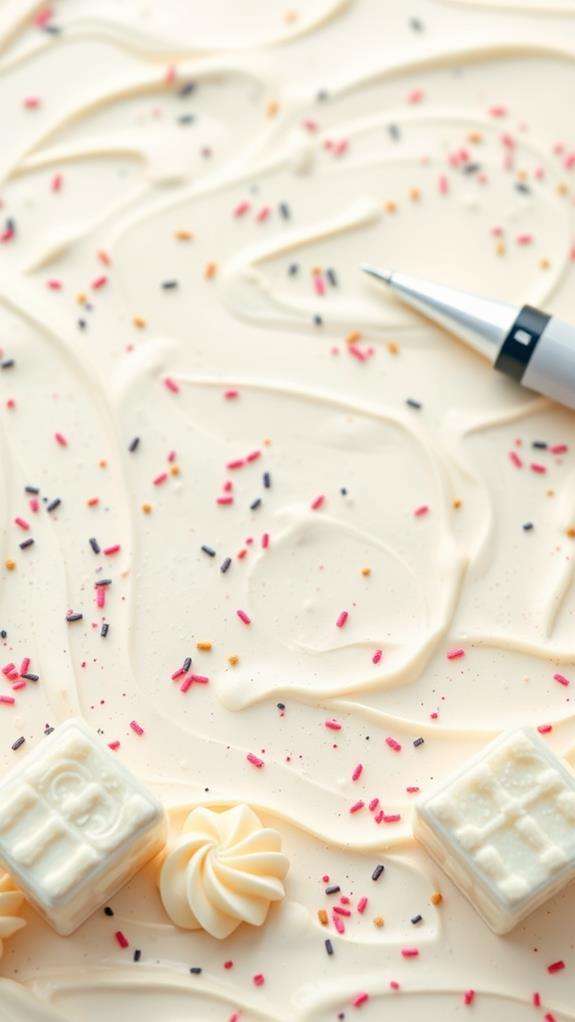
With leftover buttercream frosting in hand, you're presented with a sweet opportunity to get creative and make the most of it. Instead of letting it go to waste, consider freezing it for future use. Freezing buttercream frosting is a convenient way to store leftover frosting for up to 3 months, allowing for flexibility in future baking projects. By freezing it, you can reduce food waste and save money. When you're ready to use it, simply thaw it overnight in the refrigerator and re-whip before applying. Frozen buttercream frosting can be used to make cookie sandwiches, cake pops, or as a glaze for bundt cakes, making it a versatile ingredient for various desserts. You can also make frosting ahead of time and flavor it just before using, saving you time and effort in the long run. So, next time you have leftover buttercream frosting, don't toss it – freeze it and get creative with it later!
Buttercream Storage and Handling
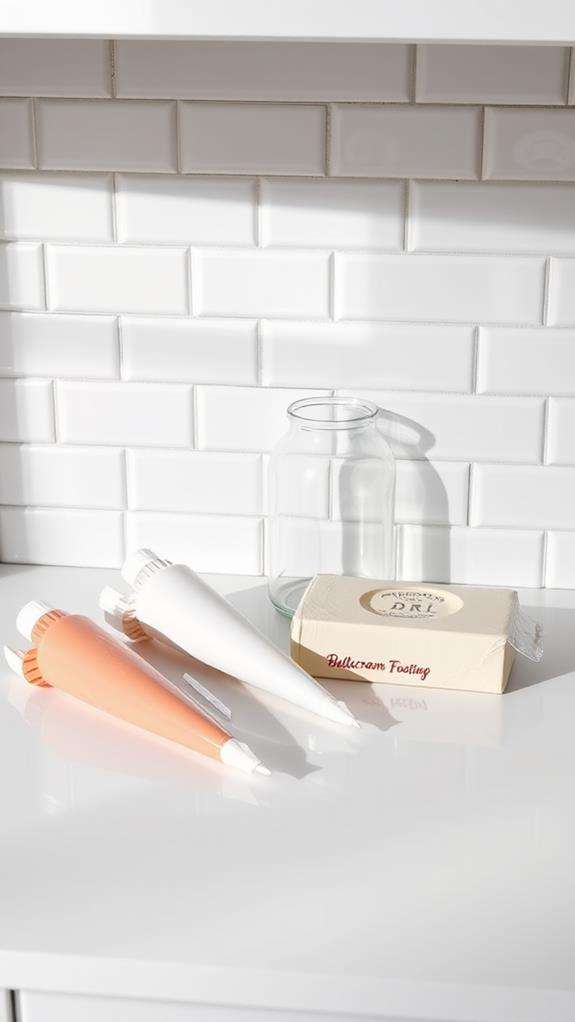
You've frozen your buttercream frosting, now it's time to think about how to store and handle it properly. When it comes to storage, you'll want to keep your frozen buttercream frosting in an airtight container to prevent freezer burn and other flavors from transferring to your frosting.
Label and date your containers: Be sure to label the container with the date you froze the frosting and what type of frosting it is, so you can easily identify it later.
Store in airtight containers: Use containers that are specifically designed for freezer storage to keep your frosting fresh.
When you're ready to use your frozen buttercream frosting, simply thaw it overnight in the refrigerator or at room temperature for a few hours.
Use within a few months: Frozen buttercream frosting is best used within 2-3 months for peak flavor and texture.
Frequently Asked Questions
What Is the Best Way to Freeze Buttercream?
When you need to freeze buttercream, start by scooping it into an airtight container or freezer bag, making sure to remove as much air as possible. Press plastic wrap directly onto the frosting's surface to prevent freezer burn. Label the container with the date and contents, then store it in the freezer for up to 3 months. When you're ready to use it, thaw overnight in the fridge and let it soften on the counter for an hour or two before re-whipping if needed.
Can Leftover Buttercream Frosting Be Frozen?
Imagine having a treasure trove of sweet possibilities in your freezer, waiting to be released in your next baking adventure. You're wondering if you can freeze leftover buttercream frosting, and the answer is yes! With proper storage, you can keep it frozen for up to 3 months. Simply press plastic wrap onto the surface, wrap it tightly, and store it in an airtight container or freezer bag. When you're ready, thaw it overnight and re-whip for a smooth, creamy texture.
What Happens if You Freeze Buttercream?
When you freeze buttercream frosting, it doesn't affect its texture or consistency. In fact, it helps preserve its flavor and prevents it from becoming too soft or runny. You can store it in an airtight container or freezer bag for up to 3 months, and then simply thaw it overnight in the fridge before re-whipping it to its original consistency.
Should You Freeze or Refrigerate Buttercream?
When deciding between freezing and refrigerating your buttercream frosting, think of it like choosing between a short-term fling and a long-term commitment. If you need the frosting within a week, refrigerating it is a good option, but be prepared for potential texture changes. However, if you want to keep it fresh for up to three months, freezing is the way to go. Just remember to press plastic wrap onto the surface to prevent freezer burn, and you'll be ready to re-whip it when the time comes.
Conclusion
As you wrap up your baking project, it's likely you've got leftover buttercream frosting lingering in the fridge or freezer. Coincidentally, you've stumbled upon this article, and now you're equipped with the know-how to store, freeze, and reuse your frosting with ease. By mastering the art of buttercream preservation, you'll reduce waste, save time, and impress your friends with your cleverness. So, go ahead and frost that cake, knowing your hard work will be just as delicious months from now.





